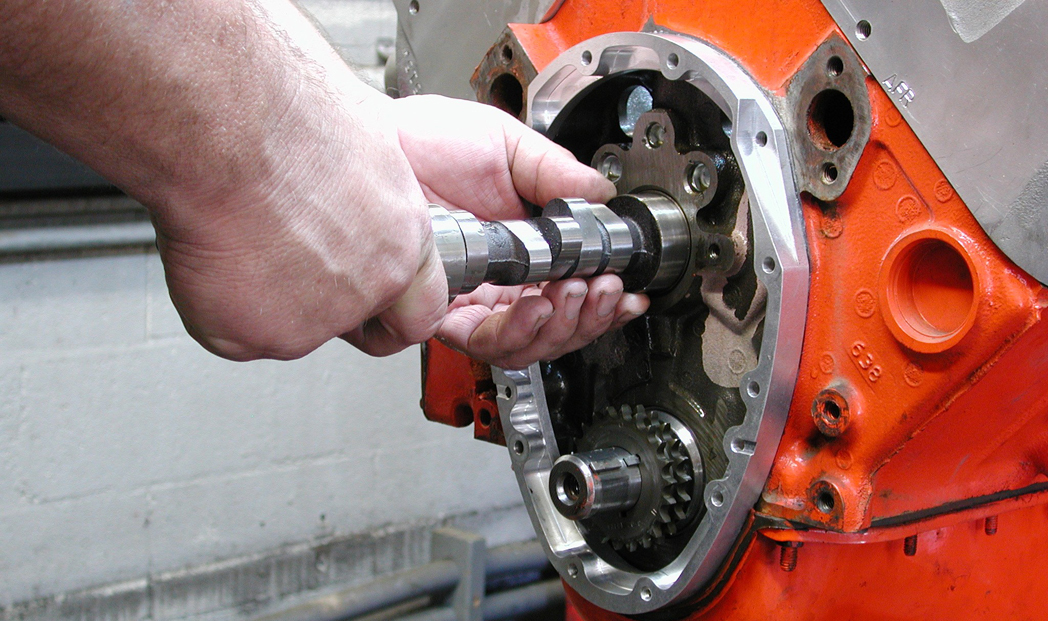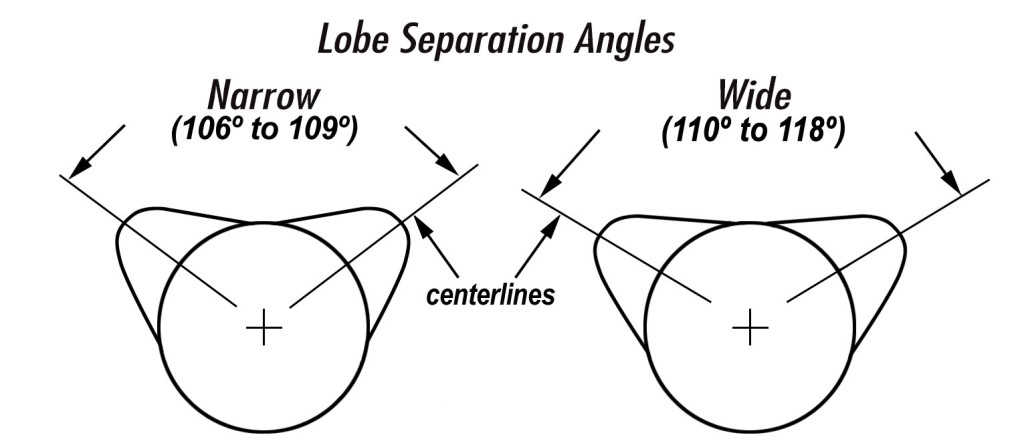“Changing the lobe separation angle,” says Doug Patton of Pro Line Race Engines, “changes the amount of overlap that exists during the time the intake and exhaust valves are both open. On a naturally aspirated engine, the lobe separation angle has an effect on whether the engine reaches peak torque a little earlier or later in the rpm range. Typically, narrower lobe separation develops peak torque at lower rpm and widening the separation tends to build peak torque higher in the rpm range. Nitrous engines, which make plenty of power and torque, often run wide lobe separation angles to moderate cylinder pressures and temperatures.“Lobe separation angles,” he continues, “are influenced by the camshaft grind. If a street car has smaller lift (the amount the valve lifts off its valve seat) and duration numbers (the degrees of crankshaft rotation for which the valve is held open) they might run 112 or 114. Widening their separation angle helps increase upper rpm power output. Alternatively, if you are running a bigger camshaft to gain maximum top-end power, cam makers often suggest reducing the lobe separation angle to recover power lost in the lower rev range.”
 Tellingly, when engine builder Chuck Lawrence received the order to bestow a 520cu in big-block Ford with the sound of a Pro Stock engine, he replaced the normal 112LSA hydraulic roller cam with one of 108LSA. “The result sounded wonderful,” said Mr. Lawrence, “but it didn’t rev as enthusiastically and it made 30hp less than normal!”“If you changed the lobe separation of a street engine from 112 degrees to 106 and didn’t do anything else,” says Jon Kaase, “the engine would idle a lot rougher and generate worse exhaust emissions largely because of unburned fuel.”
In conclusion, lobe separation angles change the amount of valve overlap, which affects many performance factors particularly idle quality, peak torque that can be moved from a lower rev range to a higher range and power bands that can be narrowed or broadened.
Tellingly, when engine builder Chuck Lawrence received the order to bestow a 520cu in big-block Ford with the sound of a Pro Stock engine, he replaced the normal 112LSA hydraulic roller cam with one of 108LSA. “The result sounded wonderful,” said Mr. Lawrence, “but it didn’t rev as enthusiastically and it made 30hp less than normal!”“If you changed the lobe separation of a street engine from 112 degrees to 106 and didn’t do anything else,” says Jon Kaase, “the engine would idle a lot rougher and generate worse exhaust emissions largely because of unburned fuel.”
In conclusion, lobe separation angles change the amount of valve overlap, which affects many performance factors particularly idle quality, peak torque that can be moved from a lower rev range to a higher range and power bands that can be narrowed or broadened.
- Erson Cams,
- Moore Good Ink




I'm no expert or anything near one, but the way I see it, separation isn't so much a setting itself as something that comes out from all the other settings. So, you decide how much peak lift for intake and exhaust, and you decide duration for intake and exhaust, and you decide what's the timing for peak lift for intake and for exhaust, and that determines overlap, so after you work that out, then separation falls out of the numbers. I suppose if you have general ideas of what some of the numbers are, then looking at separation could be a shortcut to figuring out approximately what the other numbers are. Like if everything else was the same, an engine with more separation would have less overlap than one with less separation and would probably run lousy at low RPM. It might not run better at high RPM if everything else wasn't optimal, but that's what the designer would be going for. But if the lifts and durations were different between the two engines, then all bets are off as to what the separation means.
I wonder what the lob separation angle is on my 1977 Buick 350. Peak torque is at only 1,800 rpm.
Looking at LSA on an island is an unproductive way to look at camshaft technology. LSA is a result of cam events which are the real important variables. If you reduce LSA, overlap increases, but it will also increase if you leave LSA the same and increase intake/exhaust duration. And what about profile advance/retard? Wouldn't it favor higher RPMs if the narrow LSA cam is installed with less advance or retarded? FYI, stock GM LS cams LSAs in everything truck to Corvettes are in the 114 - 119.5 LSA range, and the ones rated past 5900 RPM use VCT. On the SBF roller cams (pushrods), they are from 107.5 LSA for trucks 114-118 for the rest, yet none was rated for anything past 5500 RPM until VCT was added. Now let's take the 5.0L Coyote with stock duration @.050" of 211° int/exh. It has a park/max intake centerline of 139 / 89 and 123 / 73 for the exhaust. These values make for a minimum overlap of -25.5° and a maximum of +24.5° under different advance/retard conditions. The question is, wouldn't a higher overlap favor scavenging at higher RPM to increase intake flow and velocity, thus high RPM HP? And the other key questions are, under which overlap conditions? Intake or exhaust biased? And how biased each way and under what RPM/load conditions? Keep in mind that the Coyote is not limited to VCT (LSA is fixed) since it uses Ti-VCT (LSA is also adjustable/programmable).
Great information, good to know when picking my cam
<strong> Can someone tell me definitively which of the two differing comments on the effect of lobe seperation (overlap) on engine torque and idle is absolutely correct.
Great informative article..
I'm so confused! Cam tech has always been a foreign language for me and between the article and the first comment and then the corrected one, I'm worse off now than before. I gather that a narrow LSA produces a rougher idle; now, does it produce more or less torque in the lower to mid range RPM scale? Also, the article mentioned cam degrees, I can't get my head around that term as the shaft makes a complete turn of 360 degrees therefore the lobe must also travel 360 degrees. I realize a lifter riding the lobe travels a greater distance but how does that affect cam degrees, and wouldn't that change with the design of the lobe? As I said, "I'm so confused!"
I was just discussing with my son the reason why Pontiac used a VERY conservative cam in the 350 it put in the 74 GTO option. The engine as I recall had 7.6 to 1 mechanical compression. Why? I suspect because it raised the working compression and with its four barrel carburetor gave the car 200+ hp. That doesn’t sound like much but with a manual transmission the actually ran pretty decent. My point was GM had a lot of red tape to work around to get emissions and mpgs demands. Of course, when Chevy cam out with the LS1 it was clear this kind of thinking led to a stock cam with an LSA of 122+ which seemed just as strange to me as a duration (?) of 169 on a sport model. But I think they were fighting the same battle but Pontiac, who new hiw to build engines with horsepower, just didn’t have the technology in 1974.
I've got an Oldsmobile motor installed for marine use with a roller cam and in this application the headers are water cooled by spraying water into the headers a couple inches from the exhaust port. The problem is the engine sucks water in from the exhaust into the cylinders and ends up with water in the oil. I've done a lot of experimentation to prove this is what's happening. I was told a wider lobe separation angle would resolve this problem since the exhaust won't "see" as much of the intake vacuum. Is this true? Please advise. Thanks Paul
61lincoln